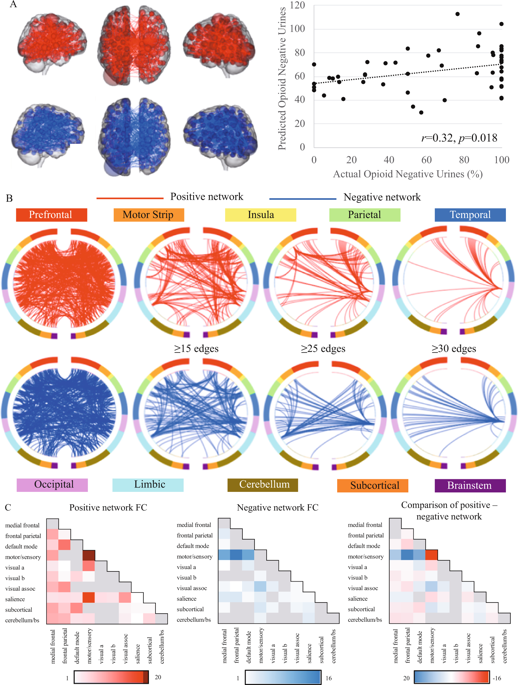当前位置:
X-MOL 学术
›
Mol. Psychiatry
›
论文详情
Our official English website, www.x-mol.net, welcomes your
feedback! (Note: you will need to create a separate account there.)
Dissociable neural substrates of opioid and cocaine use identified via connectome-based modelling.
Molecular Psychiatry ( IF 9.6 ) Pub Date : 2019-11-12 , DOI: 10.1038/s41380-019-0586-y Sarah D Lichenstein 1 , Dustin Scheinost 1 , Marc N Potenza 2 , Kathleen M Carroll 2 , Sarah W Yip 2
Molecular Psychiatry ( IF 9.6 ) Pub Date : 2019-11-12 , DOI: 10.1038/s41380-019-0586-y Sarah D Lichenstein 1 , Dustin Scheinost 1 , Marc N Potenza 2 , Kathleen M Carroll 2 , Sarah W Yip 2
Affiliation

|
Opioid use disorder is a major public health crisis. While effective treatments are available, outcomes vary widely across individuals and relapse rates remain high. Understanding neural mechanisms of treatment response may facilitate the development of personalized and/or novel treatment approaches. Methadone-maintained, polysubstance-using individuals (n = 53) participated in fMRI scanning before and after substance-use treatment. Connectome-based predictive modeling (CPM)-a recently developed, whole-brain approach-was used to identify pretreatment connections associated with abstinence during the 3-month treatment. Follow-up analyses were conducted to determine the specificity of the identified opioid abstinence network across different brain states (cognitive vs. reward task vs. resting-state) and different substance use outcomes (opioid vs. cocaine abstinence). Posttreatment fMRI data were used to assess network changes over time and within-subject replication. To determine further clinical relevance, opioid abstinence network strength was compared with healthy subjects (n = 38). CPM identified an opioid abstinence network (p = 0.018), characterized by stronger within-network motor/sensory connectivity, and reduced connectivity between the motor/sensory network and medial frontal, default mode, and frontoparietal networks. This opioid abstinence network was anatomically distinct from a previously identified cocaine abstinence network. Relationships between abstinence and opioid and cocaine abstinence networks replicated across multiple brain states but did not generalize across substances. Network connectivity measured at posttreatment related to abstinence at 6-month follow-up (p < 0.009). Healthy comparison subjects displayed intermediate network strengths relative to treatment responders and nonresponders. These data indicate dissociable anatomical substrates of opioid vs. cocaine abstinence. Results may inform the development of novel opioid-specific treatment approaches to combat the opioid epidemic.
中文翻译:

通过基于连接组的建模确定了阿片类药物和可卡因使用的可分离神经底物。
阿片类药物使用障碍是一个重大的公共卫生危机。虽然有有效的治疗方法,但个体之间的结果差异很大,复发率仍然很高。了解治疗反应的神经机制可能有助于开发个性化和/或新的治疗方法。美沙酮维持、使用多种物质的个体(n = 53)在物质使用治疗前后参与了 fMRI 扫描。基于连接组的预测模型 (CPM) - 最近开发的一种全脑方法 - 用于识别与 3 个月治疗期间禁欲相关的预处理连接。进行后续分析以确定已识别的阿片类药物戒断网络在不同大脑状态(认知与奖励任务与静息状态)和不同物质使用结果(阿片类药物与精神状态)之间的特异性。可卡因禁欲)。治疗后 fMRI 数据用于评估网络随时间的变化和受试者内的复制。为了进一步确定临床相关性,将阿片类药物戒断网络强度与健康受试者(n = 38)进行了比较。CPM 确定了一个阿片类药物戒断网络 (p = 0.018),其特点是网络内运动/感觉连接性更强,运动/感觉网络与内侧额叶、默认模式和额顶叶网络之间的连接性降低。这种阿片类药物戒断网络在解剖学上与先前确定的可卡因戒断网络不同。禁欲与阿片类药物和可卡因禁欲网络之间的关系在多个大脑状态中复制,但并未在物质之间推广。治疗后测量的网络连接与 6 个月随访时的禁欲有关(p < 0.009)。相对于治疗反应者和无反应者,健康对照受试者显示出中等网络强度。这些数据表明阿片类药物与可卡因禁欲的可解离解剖学底物。结果可能会为开发新的阿片类药物特异性治疗方法以对抗阿片类药物流行提供信息。
更新日期:2019-11-13
中文翻译:

通过基于连接组的建模确定了阿片类药物和可卡因使用的可分离神经底物。
阿片类药物使用障碍是一个重大的公共卫生危机。虽然有有效的治疗方法,但个体之间的结果差异很大,复发率仍然很高。了解治疗反应的神经机制可能有助于开发个性化和/或新的治疗方法。美沙酮维持、使用多种物质的个体(n = 53)在物质使用治疗前后参与了 fMRI 扫描。基于连接组的预测模型 (CPM) - 最近开发的一种全脑方法 - 用于识别与 3 个月治疗期间禁欲相关的预处理连接。进行后续分析以确定已识别的阿片类药物戒断网络在不同大脑状态(认知与奖励任务与静息状态)和不同物质使用结果(阿片类药物与精神状态)之间的特异性。可卡因禁欲)。治疗后 fMRI 数据用于评估网络随时间的变化和受试者内的复制。为了进一步确定临床相关性,将阿片类药物戒断网络强度与健康受试者(n = 38)进行了比较。CPM 确定了一个阿片类药物戒断网络 (p = 0.018),其特点是网络内运动/感觉连接性更强,运动/感觉网络与内侧额叶、默认模式和额顶叶网络之间的连接性降低。这种阿片类药物戒断网络在解剖学上与先前确定的可卡因戒断网络不同。禁欲与阿片类药物和可卡因禁欲网络之间的关系在多个大脑状态中复制,但并未在物质之间推广。治疗后测量的网络连接与 6 个月随访时的禁欲有关(p < 0.009)。相对于治疗反应者和无反应者,健康对照受试者显示出中等网络强度。这些数据表明阿片类药物与可卡因禁欲的可解离解剖学底物。结果可能会为开发新的阿片类药物特异性治疗方法以对抗阿片类药物流行提供信息。











































 京公网安备 11010802027423号
京公网安备 11010802027423号